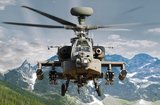First flight of Mi-38 prototype with TV7-117V engines
Russian Helicopters has commenced flight tests of its prototype Mi-38 multirole helicopter fitted with Russian-built TV7-117V engines, the company announced on 17 December.
The first flight of the third Mi-38 prototype took place on 29 November, following the completion of initial hover tests earlier in the month. As part of its testing plan, the Mi-38 completed a circuit of the flight-testing centre of Mil Moscow Helicopter Plant in Tomilino, Moscow.
The Mi-38 multirole helicopter is a joint production between Russian Helicopters, and United Engine Corporation (UEC), both subsidiaries of Oboronprom, part of State Corporation Rostec.
‘The Mi-38’s first flight is the successful result of collaboration between Russian helicopter constructors and engine-builders,’ said Russian Helicopters CEO Alexander Mikheev.
‘Thanks to its TV7-117V engines, the Mi-38 has a significantly broader range of potential applications, which will give it an additional competitive edge,’ Mikheev added.
Following the successful test results, a quick transition to in-house certification tests of the new aircraft to Russian AP-29 standards is anticipated.
Certification of the Mi-38 is expected to be completed in 2015, with serial production then slated to commence at the Kazan Helicopter Plant, based at Kazan, Tatarstan.
Serially produced Mi-38s will be fitted with the Klimov TV7-117V engines, which were purpose-built for the new platform by UEC.
‘Construction of a test batch of the TV7-117Vs will begin shortly for certification testing, which is planned for the end of 2014,’ said UEC CEO Vladislav Masalov.
According to UEC, the new turboshaft TV7-117Vs generate thrust of 2,500-3,000 hp, and are based on the TV7-117 turboprop engine, with which they are more than 90% compatible.
The TV7-117Vs have the capacity to provide of 2,800-3,750 hp of emergency power when necessary, and feature a new FADEC system that uses the BARK-12 or BARK-57 electronic engine control unit.
The second prototype Mi-38, fitted with Pratt & Whitney Canada Engines, completed its first flight on 24 December 2010.
The fourth and final prototype Mi-38 is currently being assembled at the Kazan Helicopter Plant, and will be fitted with a shock-resistant fuel system by Aerazur, and enlarged window openings.
The multirole Mi-38 can be used for cargo, passenger and VIP transport, and can also serve as a flying hospital and for offshore operations.
Related Equipment in Defence Insight
More from Defence Helicopter
-
![Germany to send WS-61 Westland Sea King helicopters to Ukraine]()
Germany to send WS-61 Westland Sea King helicopters to Ukraine
Germany has committed to sending Ukraine six of its 21 retiring WS-61 Westland Sea King multirole, amphibious helicopters.
-
![Boeing secures $271 million to advance modernisation of US Special Operations' MH-47G Chinook]()
Boeing secures $271 million to advance modernisation of US Special Operations' MH-47G Chinook
Boeing has clinched a major contract modification to further its backing of the US Special Operations Command’s MH-47G Chinook aircraft modernisation effort.
-
![Dubai Airshow 2023: South Korean homegrown helicopters make international debut]()
Dubai Airshow 2023: South Korean homegrown helicopters make international debut
Two KAI helicopters, the KUH-1E utility helicopter and the Light Attack Helicopter (LAH), have taken centre stage at the Dubai Airshow 2023.
-
![Italian Navy receives final NH90 helicopter]()
Italian Navy receives final NH90 helicopter
The Italian Navy now boasts a fleet of 56 NH90 helicopters comprising 46 SH-90As and 10 MH-90As.
-
![Argentina seeks AW109 and CH-46 Sea Knight helicopters]()
Argentina seeks AW109 and CH-46 Sea Knight helicopters
The Argentinian Air Force (FAA) and the Argentinian Naval Aviation Command (COAN) are looking for options to upgrade their helicopter fleets.
-
![DSEI 2023: Lockheed to produce about 40% of Black Hawks on UK soil if it wins NMH contest]()
DSEI 2023: Lockheed to produce about 40% of Black Hawks on UK soil if it wins NMH contest
Lockheed Martin promises a boost to the British job market and export opportunities, while strengthening ties with Poland and positioning the UK for a future in rotorcraft technology in the event of a New Medium Helicopter competition triumph.



























